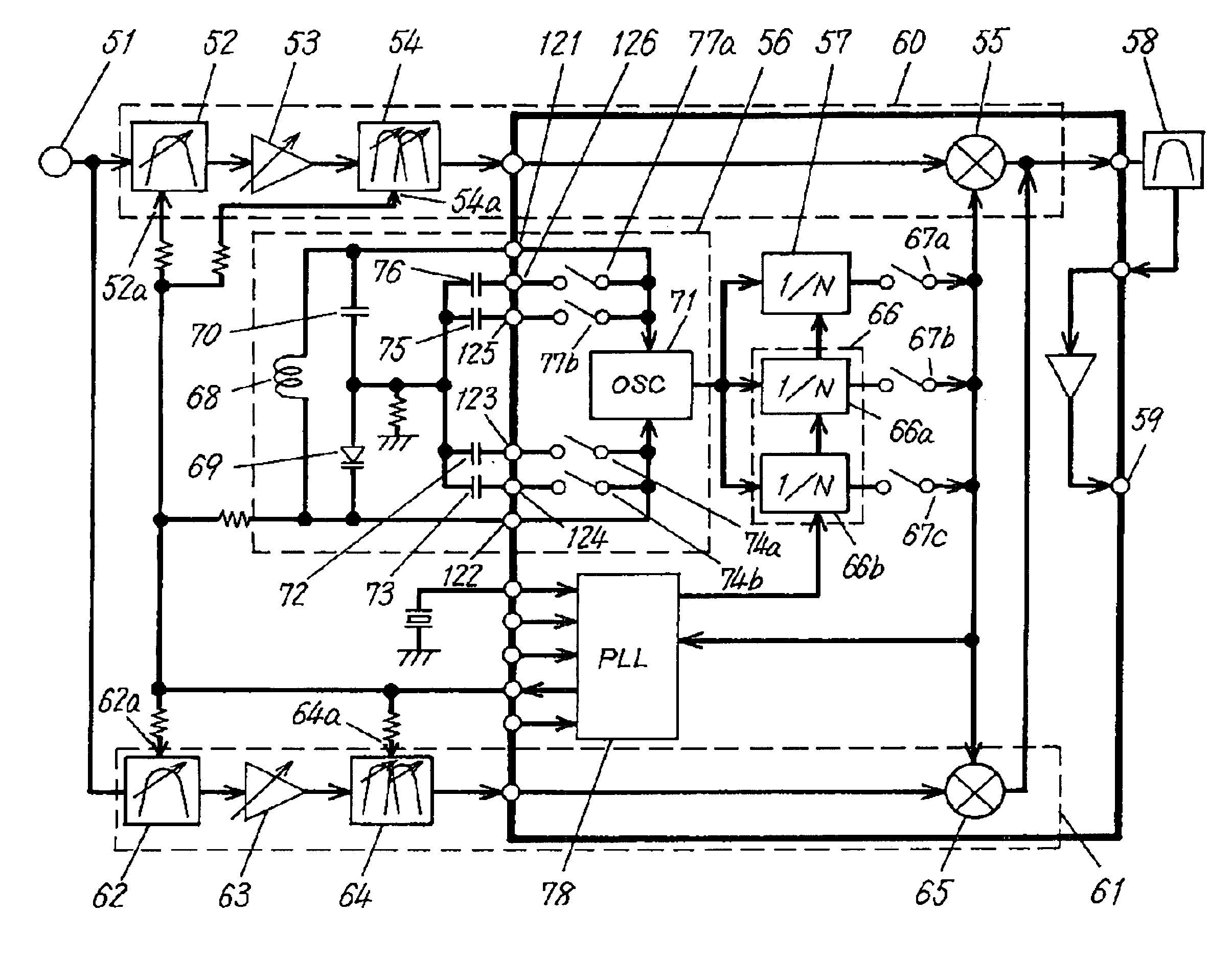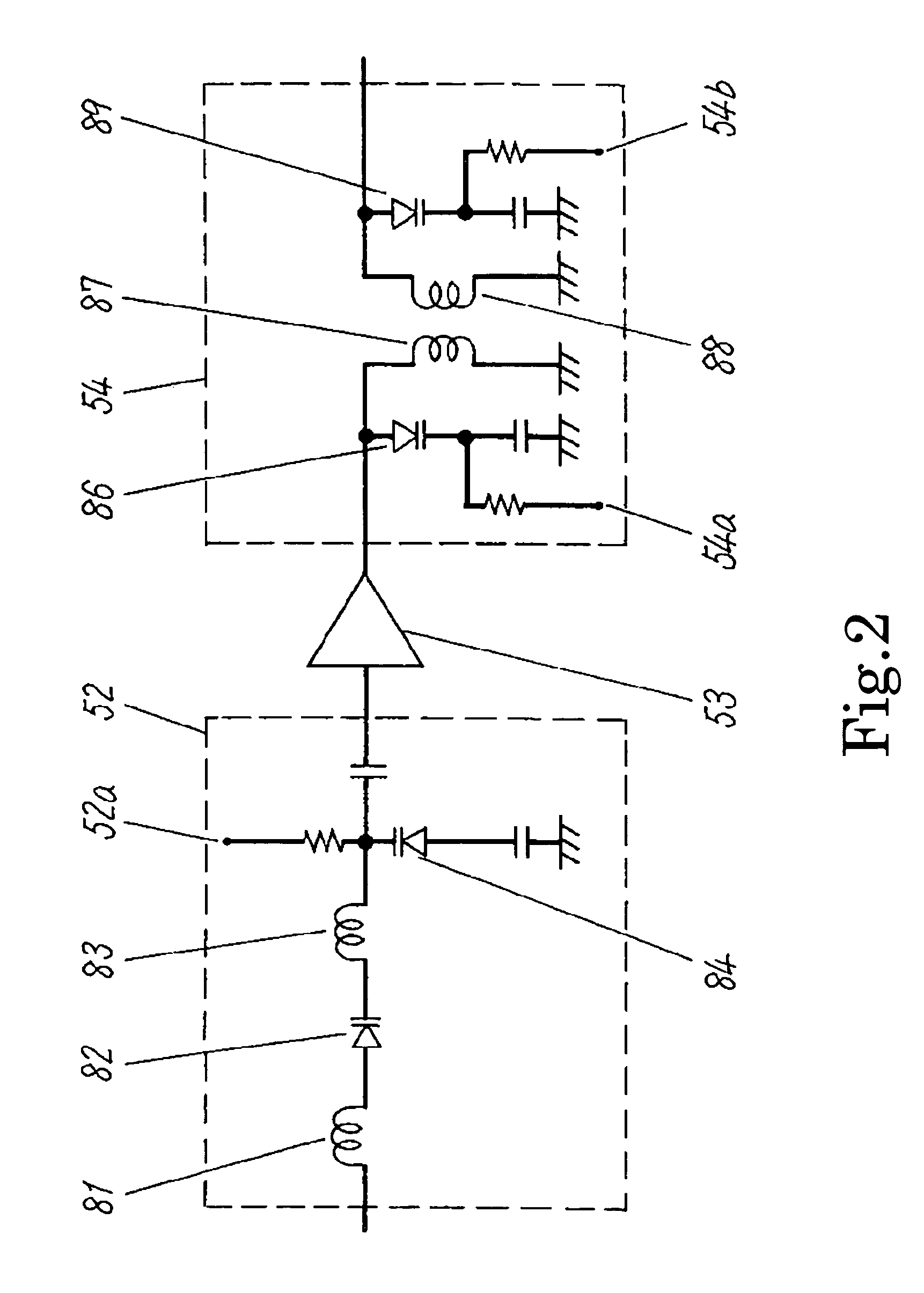High frequency receiving device, integrated circuit used for the same, and TV receiver using them
a technology of high frequency and receiving device, which is applied in the direction of television system, multi-resonant circuit tuned to different frequencies, and discontnuous tuning with seperate pre-tuned circuits, etc., can solve the problem that certain frequency ranges cannot be received, and achieve the effect of widening the oscillation frequency rang
- Summary
- Abstract
- Description
- Claims
- Application Information
AI Technical Summary
Benefits of technology
Problems solved by technology
Method used
Image
Examples
first preferred embodiment
(First Preferred Embodiment)
[0036]The first preferred embodiment of the present invention will be described in the following with reference to the drawings. FIG. 1 is a block diagram of a high frequency receiving device in the first preferred embodiment.
[0037]In FIG. 1, a high frequency signal ranging from 55.25 MHz to 801.25 MHz is inputted to input terminal 51. The high frequency signal is fed to single tuning filter 52. The single tuning filter 52 is a single tuning filter including one variable capacity diode, and is able to vary the tuning frequency by using the tuning voltage applied to frequency variable terminal 52a. The tuning frequency of single tuning filter 52 ranges from 367.25 MHz to 801.25 MHz of UHF broadcast band.
[0038]The output of single tuning filter 52 is connected to high frequency amplifier 53, and high frequency amplifier 53 amplifies the signal of UHF broadcast band. The output of high frequency amplifier 53 is connected to double tuning filter 54. The doubl...
second preferred embodiment
(Second Preferred Embodiment)
[0093]In the second preferred embodiment, UHF broadcast band and VHF broadcast band are received by using only one mixer. Accordingly, it contributes to the reduction in size and cost. The second preferred embodiment will be described in the following. Incidentally, those same as in the first preferred embodiment are given same reference numerals, and the description is simplified.
[0094]FIG. 5 is a block diagram of a high frequency receiving device in the second preferred embodiment. In FIG. 5, broadcasting waves of UHF broadcast band and VHF broadcast band are inputted to input terminal 132. And, to input terminal 132 are connected in parallel fashion, for UHF broadcast band passing, the first series connection body with single tuning filter 52, high frequency amplifier 53, and double tuning filter 54 connected in this order, and for VHF broadcast band passing, the second series connection body with single tuning filter 62, high frequency amplifier 63, ...
third preferred embodiment
(Third Preferred Embodiment)
[0100]The third preferred embodiment will be described in the following with reference to the drawings. FIG. 6 is a block diagram of an essential portion of a television broadcast receiver using a high frequency receiving device in the third preferred embodiment. In the third preferred embodiment, same component elements as those in the first preferred embodiment are given same reference numerals, and the description is simplified.
[0101]In FIG. 6, single tuning filter 52 is connected to input terminal 51, and includes one variable capacity diode. Single tuning filter 52 is able to vary its tuning frequency by using the tuning voltage applied to frequency variable terminal 52a in a range from 367.25 MHz to 801.25 MHz of UHF broadcast band.
[0102]Double tuning filter 54 is connected to the output of high frequency amplifier 53. Double tuning filter 54 includes two variable capacity diodes and is able to vary its tuning frequency by using the tuning voltage a...
PUM
 Login to View More
Login to View More Abstract
Description
Claims
Application Information
 Login to View More
Login to View More - R&D
- Intellectual Property
- Life Sciences
- Materials
- Tech Scout
- Unparalleled Data Quality
- Higher Quality Content
- 60% Fewer Hallucinations
Browse by: Latest US Patents, China's latest patents, Technical Efficacy Thesaurus, Application Domain, Technology Topic, Popular Technical Reports.
© 2025 PatSnap. All rights reserved.Legal|Privacy policy|Modern Slavery Act Transparency Statement|Sitemap|About US| Contact US: help@patsnap.com



